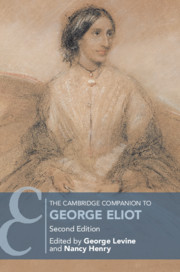99 results
COVID-19 and psychogeriatrics: the view from Australia
-
- Journal:
- International Psychogeriatrics / Volume 32 / Issue 10 / October 2020
- Published online by Cambridge University Press:
- 12 May 2020, pp. 1135-1141
-
- Article
-
- You have access
- Open access
- HTML
- Export citation
9 - George Eliot and Politics
-
-
- Book:
- The Cambridge Companion to George Eliot
- Published online:
- 25 January 2019
- Print publication:
- 31 January 2019, pp 155-174
-
- Chapter
- Export citation
Copyright page
-
- Book:
- The Cambridge Companion to George Eliot
- Published online:
- 25 January 2019
- Print publication:
- 31 January 2019, pp iv-iv
-
- Chapter
- Export citation
Contents
-
- Book:
- The Cambridge Companion to George Eliot
- Published online:
- 25 January 2019
- Print publication:
- 31 January 2019, pp vii-viii
-
- Chapter
- Export citation
1 - Introduction: George Eliot and the Art of Realism
-
-
- Book:
- The Cambridge Companion to George Eliot
- Published online:
- 25 January 2019
- Print publication:
- 31 January 2019, pp 1-18
-
- Chapter
-
- You have access
- HTML
- Export citation
Index
-
- Book:
- The Cambridge Companion to George Eliot
- Published online:
- 25 January 2019
- Print publication:
- 31 January 2019, pp 275-282
-
- Chapter
- Export citation
Chronology
-
- Book:
- The Cambridge Companion to George Eliot
- Published online:
- 25 January 2019
- Print publication:
- 31 January 2019, pp xiii-xviii
-
- Chapter
- Export citation
Guide to Further Reading
-
- Book:
- The Cambridge Companion to George Eliot
- Published online:
- 25 January 2019
- Print publication:
- 31 January 2019, pp 259-274
-
- Chapter
- Export citation
Notes on Contributors
-
- Book:
- The Cambridge Companion to George Eliot
- Published online:
- 25 January 2019
- Print publication:
- 31 January 2019, pp ix-xii
-
- Chapter
- Export citation
Dedication
-
- Book:
- The Cambridge Companion to George Eliot
- Published online:
- 25 January 2019
- Print publication:
- 31 January 2019, pp v-vi
-
- Chapter
- Export citation
Texts and Abbreviations
-
- Book:
- The Cambridge Companion to George Eliot
- Published online:
- 25 January 2019
- Print publication:
- 31 January 2019, pp xix-xx
-
- Chapter
- Export citation

The Cambridge Companion to George Eliot
-
- Published online:
- 25 January 2019
- Print publication:
- 31 January 2019
Aeron Hunt. Personal Business: Character and Commerce in Victorian Literature and Culture. Charlottesville: University of Virginia Press, 2014. x + 225 pp. ISBN 978-0-8139-3631-4, $39.50 (cloth); ISBN 978-0-8139-3632-1, $39.50 (e-book).
-
- Journal:
- Enterprise & Society / Volume 19 / Issue 1 / March 2018
- Published online by Cambridge University Press:
- 21 January 2018, pp. 226-228
- Print publication:
- March 2018
-
- Article
- Export citation
2008 AND ALL THAT: ECONOMICS AND VICTORIAN LITERATURE
-
- Journal:
- Victorian Literature and Culture / Volume 43 / Issue 1 / March 2015
- Published online by Cambridge University Press:
- 06 February 2015, pp. 217-222
-
- Article
- Export citation
Contributors
-
-
- Book:
- George Eliot in Context
- Published online:
- 05 June 2013
- Print publication:
- 30 May 2013, pp xii-xvi
-
- Chapter
- Export citation
Chapter 4 - Genre
- from Part I - Life and afterlife
-
-
- Book:
- George Eliot in Context
- Published online:
- 05 June 2013
- Print publication:
- 30 May 2013, pp 34-40
-
- Chapter
- Export citation
Notes on Contributors
-
-
- Book:
- The Cambridge Handbook of Environment in Human Development
- Published online:
- 05 October 2012
- Print publication:
- 27 August 2012, pp ix-xvi
-
- Chapter
- Export citation
Contributors
-
-
- Book:
- Multiple Sclerosis Therapeutics
- Published online:
- 05 December 2011
- Print publication:
- 20 October 2011, pp viii-xii
-
- Chapter
- Export citation
Contributors
-
-
- Book:
- The Cambridge Handbook of Intelligence
- Published online:
- 05 June 2012
- Print publication:
- 30 May 2011, pp xi-xiv
-
- Chapter
- Export citation
THE ROMOLA CODE: “MEN OF APPETITES” IN GEORGE ELIOT'S HISTORICAL NOVEL
-
- Journal:
- Victorian Literature and Culture / Volume 39 / Issue 2 / September 2011
- Published online by Cambridge University Press:
- 18 May 2011, pp. 327-348
-
- Article
- Export citation



